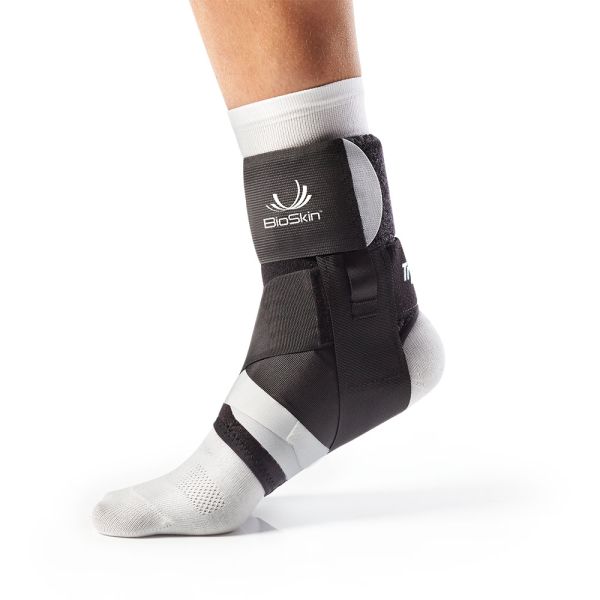At Dunbar Medical, we aim to provide the very best products to help our customers prevent or manage injuries from their sporting, occupational or recreational activities. Among these products are orthopedic braces like ankle supports, wrist braces, back supports or knee braces. We also provide medical tapes such as zinc oxide or kinesiology tape, as well as a range of compression products designed to optimize sports performance and reduce the risk of injury. The decision on the type of product to use for treatment of sports injuries depends on the type of injury experienced and on the nature of the treatment involved. These factors are explained below.
Sports injuries can be classified into three categories – traumatic, catastrophic and overuse/ repetitive stress injuries.
Traumatic Sports Injuries
These account for most of the injuries experienced in contact sports such as soccer, hockey, rugby and football (American or Canadian). They are mainly caused by collisions with the ground, other players or other objects. These collisions, and the resultant dynamic unexpected forces on limbs and joints, can cause sports related injuries.
Examples of traumatic sports injuries include contusions or bruises,muscle strains, ligament sprains, wounds, bone fractures and cramps (powerful and involuntary muscle contractions lasting for a few minutes at a time).
Orthopedic braces or athletic tape may be used in the treatment or management of some traumatic sports injuries as part of either a preventative or rehabilitative approach.
Catastrophic Sports Injuries
A catastrophic injury is defined as a severe traumatic injury affecting the head, spine or brain. Perhaps the most common form of catastrophic sports injury is concussion, which has been observed in contact sports like football as well as in boxing, but can also affect athletes involved in other sports.
The long term effects of repeated concussions include progressive degenerative diseases like dementia (dementia pugilistica is particularly common among boxers but has also been observed in other sports). Another, closely related condition is chronic traumatic encephalopathy (CTE) which is particularly prevalent among football players.
Overuse and Repetitive Stress Injuries
This is the injury category that is addressed by most of Dunbar Medical’s products. It is important to note that many of these injuries can result from occupational (typing) or recreational (gardening) activities and are not only related to sporting activities.
Repetitive Stress Injury is an umbrella term that includes several discrete conditions resulting from repetitive tasks, forceful exertions, vibrations, mechanical compression or the holding of an awkward body position over a sustained period. Examples of these injuries include carpal tunnel syndrome, tennis elbow and trigger finger.
The widespread introduction of computers to modern workplaces has resulted in a significant increase in repetitive stress injuries in the arm, neck, shoulder and hand regions due to the need to carry out repetitive actions over long periods while maintaining a fixed body position. Carpal Tunnel Syndrome is perhaps the best known example of these injuries.
Repetitive Stress Injury symptoms can include aching, pulsing pain, tingling and extremity weakness.
Depending on the severity of the condition, orthopedic braces or athletic tape may be part of the management and treatment of a repetitive stress injury. Other frequently prescribed approaches to the treatment of early stage repetitive stress injuries are analgesics, physical therapy and ultrasound therapy.
Approaches to Treatment of Sports Injuries
The various approaches to the treatment of sports related injuries may be divided into three categories – primary, secondary and tertiary.
Primary Approaches

The primary approach is focused on the avoidance of the injury in the first place.This may involve, for example, the wearing of an ankle orthopedic brace, even by an athlete with no previous history of ankle problems. Another important step in primary injury prevention is the establishment of a proper warm up or stretching program prior to the commencement of serious athletic activity. Provided the warm up and stretching is focused on the muscle groups primarily used in the intended sporting activity, they will significantly reduce the risk of traumatic sports injuries such as muscle cramps, torn muscles and stress fractures.
In addition to the above strategies, primary prevention may include taking measures to ensure proper nutrition and hydration for the athlete before training or competition. As an example, the occurrence of cramping is correlated with the lack of adequate hydration before and during activity.
Screening for potential injury risks can also be undertaken using physical examinations that focus on e.g. the mobility and stability of joints, strength and power of muscles and breathing patterns.
Secondary Approaches
The secondary approach to sport injury treatment is the diagnosis and treatment of an injury as soon as possible after its occurrence. The aim of this approach is to limit the scope for the emergence of other medical problems that may otherwise stem from the initial traumatic event.
Tertiary Approaches
The tertiary approach to sport injury treatment is focused on rehabilitation in order to reduce and correct the injury or disability resulting from the initial traumatic event. This would include the use of equipment for exercises aimed at gradually improving strength, mobility and other functions critical to peak athletic performance.
The use of a properly designed orthopedic brace or of athletic tape or kinesiology tape can also be an important part of a well designed rehabilitative approach to injury treatment. As explained here, the use of such devices will help to support the injured joint or muscle or to restrict its range of movement in order to reduce the risk of re-injury during the gradual return to normal activity.


